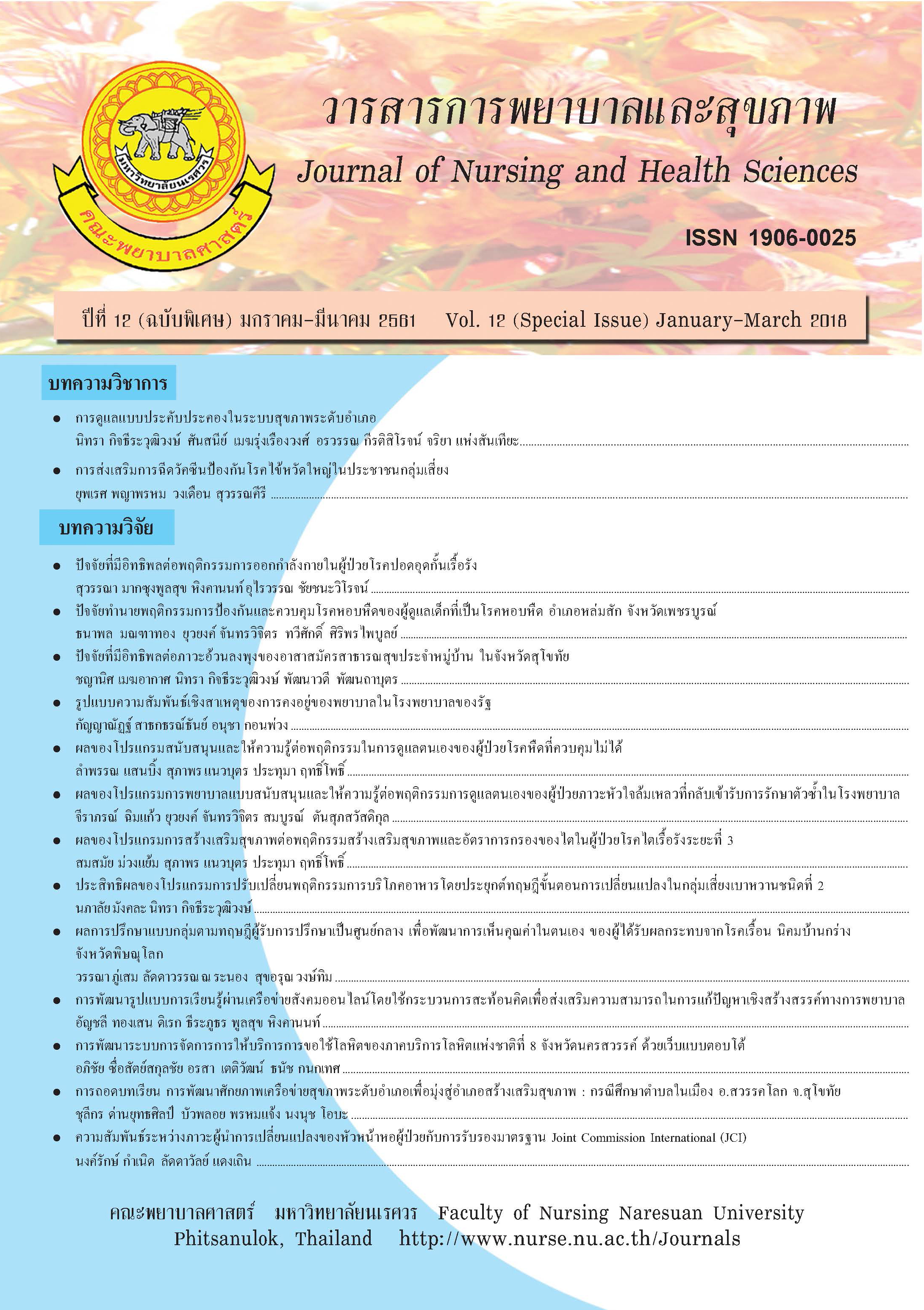ผลของโปรแกรมการพยาบาลแบบสนับสนุนและให้ความรู้ต่อพฤติกรรมการดูแลตนเอง ของผู้ป่วยภาวะหัวใจล้มเหลวที่กลับเข้ารับการรักษาตัวซ้ำในโรงพยาบาล
Main Article Content
บทคัดย่อ
การวิจัยกึ่งทดลองครั้งนี้เป็นการศึกษาแบบหนึ่งกลุ่มวัดก่อนและหลังการทดลอง มีวัตถุประสงค์เพื่อศึกษา ผลของโปรแกรมการพยาบาลแบบสนับสนุนและให้ความรู้ต่อพฤติกรรมการดูแลตนเองกลุ่มตัวอย่างคือ ผู้ป่วยภาวะหัวใจล้มเหลวที่กลับเข้ารับการรักษาตัวซ้ำในโรงพยาบาล จังหวัดพิษณุโลก คัดเลือกกลุ่มตัวอย่าง แบบเจาะจง ตามเกณฑ์ที่กำหนด จำนวน 30 ราย กลุ่มตัวอย่างได้รับโปรแกรมการพยาบาลแบบสนับสนุน และให้ความรู้ โดยประยุกต์ใช้แนวคิดของโอเร็ม ประกอบด้วยการสอน การชี้แนะ การสนับสนุนและ การสร้างสิ่งแวดล้อม กิจกรรมประกอบด้วยการออกเยี่ยมบ้านและสอนให้ความรู้เป็นรายบุคคลที่บ้าน ของผู้ป่วย การชี้แนะ การสนับสนุนโดยโทรศัพท์ติดตามอาการ ระยะเวลาการดำเนินโปรแกรม 9 สัปดาห์ และประเมินพฤติกรรมการดูแลตนเองหลังจากดำเนินโปรแกรมครบ 12 สัปดาห์ เครื่องมือที่ใช้ในการดำเนิน การวิจัย ได้แก่ โปรแกรมการพยาบาลแบบสนับสนุนและให้ความรู้ คู่มือการดูแลตนเอง และแบบสอบถาม พฤติกรรมการดูแลตนเอง สร้างขึ้นจากการทบทวนวรรณกรรมตรวจสอบเนื้อหาโดยผู้เชี่ยวชาญ 5 ท่าน ค่าดัชนีความตรงเชิงเนื้อหาเท่ากับ 0.96 ค่าความเชื่อมั่นสัมประสิทธิ์แอลฟาครอนบาค เท่ากับ 0.75 วิเคราะห์ ข้อมูลโดยใช้สถิติเชิงพรรณนา และPair t-test ผลการศึกษาครั้งนี้ พบว่าผู้ป่วยภาวะหัวใจล้มเหลวที่ได้รับโปรแกรมการพยาบาลแบบสนับสนุนและ ให้ความรู้มีค่าเฉลี่ยของคะแนนพฤติกรรมการดูแลตนเองหลังการทดลองสูงกว่าก่อนทดลองอย่างมีนัยสำคัญ ทางสถิติ (p < 0.001)ผลการศึกษาครั้งนี้พบว่าโปรแกรมการพยาบาลแบบสนับสนุนและให้ความรู้มีประสิทธิภาพในการปรับ เปลี่ยนพฤติกรรมการดูแลตนเองของผู้ป่วยภาวะหัวใจล้มเหลวดังนั้นจึงควรประยุกต์โปรแกรมการพยาบาล แบบสนับสนุนและให้ความรู้ เพื่อนำไปใช้ในการป้องกันการกลับเข้ารับการรักษาตัวซ้ำในโรงพยาบาล
Article Details
เอกสารอ้างอิง
สาร กระทรวงสาธารณสุข.(2557).สถิติโรค.สืบ
ค้นเมื่อ 2 กรกฎาคม 2558, จาก http://www.
dms.moph.go.th.
กระทรวงสาธารณสุข. (2557). สถิติสาธารณสุข.สืบค้น
เมื่อ 2 กรกฎาคม 2558,จากhttp://www.moph.
gov.th.
จันทร์จิรา เกียรติสี่สกุล, สุปรีดา มั่นคง, อรสา พันธ์ุภักดี
และธนรัตน์ ชุนงาม. (2551). ผลของโปรแกรม
การสนับสนุนให้ความรู้ ต่อความรู้ พฤติกรรม
การดูแลตนเอง และระดับความรุนแรงของภาวะ
หัวใจล้มเหลว. วารสารพยาบาลโรคหัวใจและ
ทรวงอก,19(2), 23-39.
นิภาพร ประจันบาน. (2550). ผลของโปรแกรมการ
ส่งเสริมความสามารถของผู้ป่วยและญาติในการ
ดูแลผู้ป่วยภาวะหัวใจล้มเหลวต่อการกลับเข้ารับ
การรักษาซ้ำในโรงพยาบาล. วิทยานิพนธ์ พย.ม.,
สาขาการพยาบาลผู้ใหญ่, บัณฑิตวิทยาลัย,
มหาวิทยาลัยมหิดล.
ผ่องพรรณ อรุณแสง. (2551). การพยาบาลผู้ป่วยโรค
หัวใจและหลอดเลือด(พิมพ์ครั้งที่ 5).ขอนแก่น:
โรงพิมพ์คลังนาวิทยา.
พิกุล บุญช่วง. (2541). การพยาบาลผู้ป่วยภาวะหัวใจ
ล้มเหลว (พิมพ์ครั้งที่ 2). เชียงใหม่: โครงการ
ตำรามหาวิทยาลัยเชียงใหม่.
ไพเราะ ผ่องโชค. (2550). การพยาบาลอนามัยชุมชน
(พิมพ์ครั้งที่ 2). กรุงเทพฯ: จุดทอง.
รัตน์ศิริ ทาโต. (2552). การวิจัยทางการพยาบาล:
แนวคิดสู่การประยุกต์ใช้ (พิมพ์ครั้งที่ 2).
กรุงเทพ: โรงพิมพ์แห่งจุฬาลงกรณ์มหาวิทยาลัย.
โรงพยาบาลพุทธชินราช พิษณุโลก. (2558).เวชระเบียน
และสถิติ. พิษณุโลก: โรงพยาบาลพุทธชินราช
พิษณุโลก.
สมจิต หนุเจริญกุล. (2543). การพยาบาลทางอายุรศาสตร์
เล่ม 2(พิมพ์ครั้งที่ 13). กรุงเทพฯ: วี.เจ.พริ้นติ้ง.
Artinian, N.T., Magnan, M., Sloan, M., & Lange, M.
P., (2002). Self-care behaviors among patients
with heart failure. Heart & Lung,31(3), 161-172.
Francis, G. S., Wilson Tang, W. H., &Sonnenblick, E.
H. (2004).The pathophysiology of heart failure.
In V.Fuster. R.
W.Alexander,&R. A. O’Rourke(Eds). Hurst’s the heart
(pp 697-792). New York: McGraw-Hill.
Orem, D. E. (2001).Nursing concepts of practice
(6thed.). St, Louis: Mosby Year Book.


